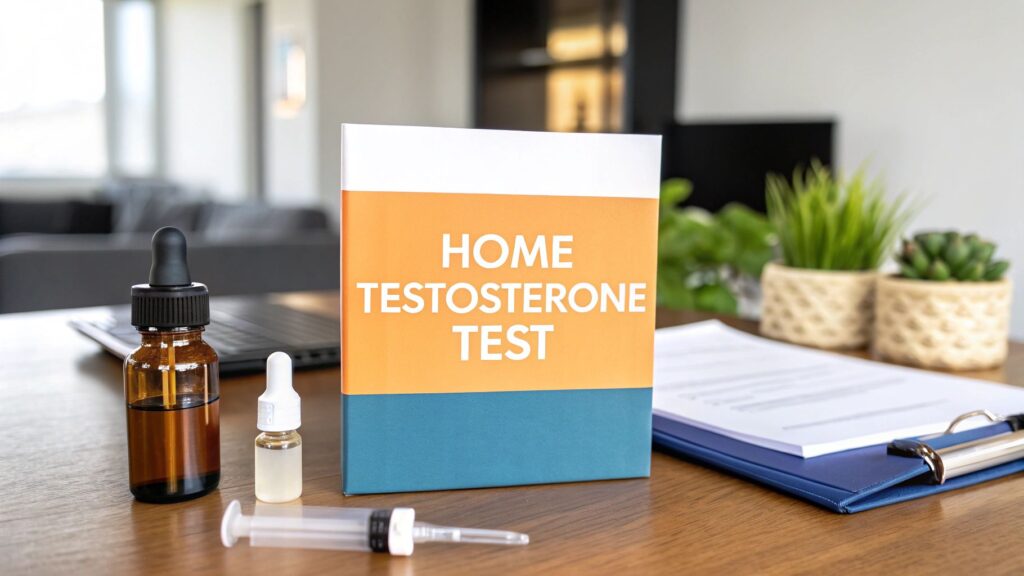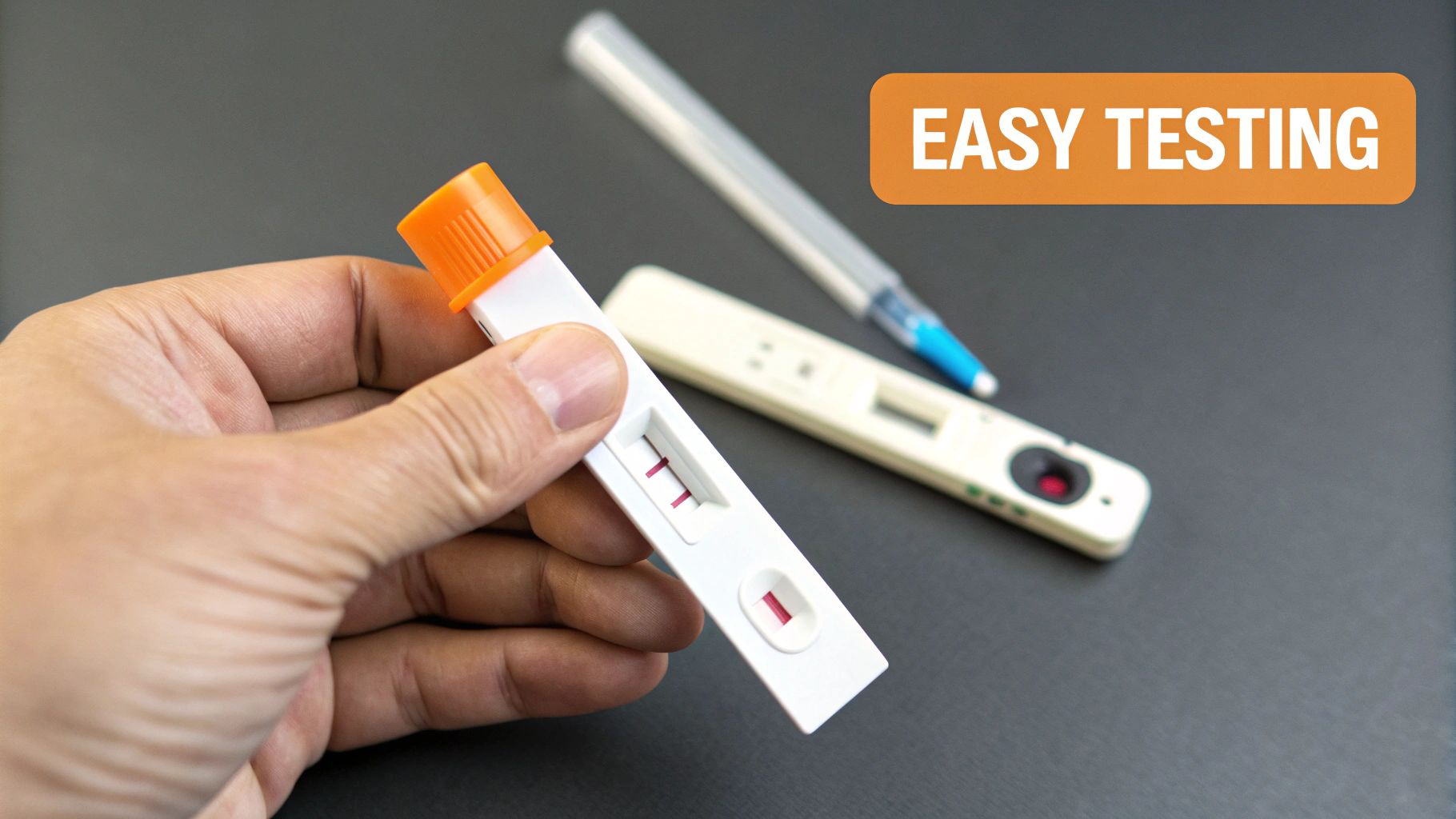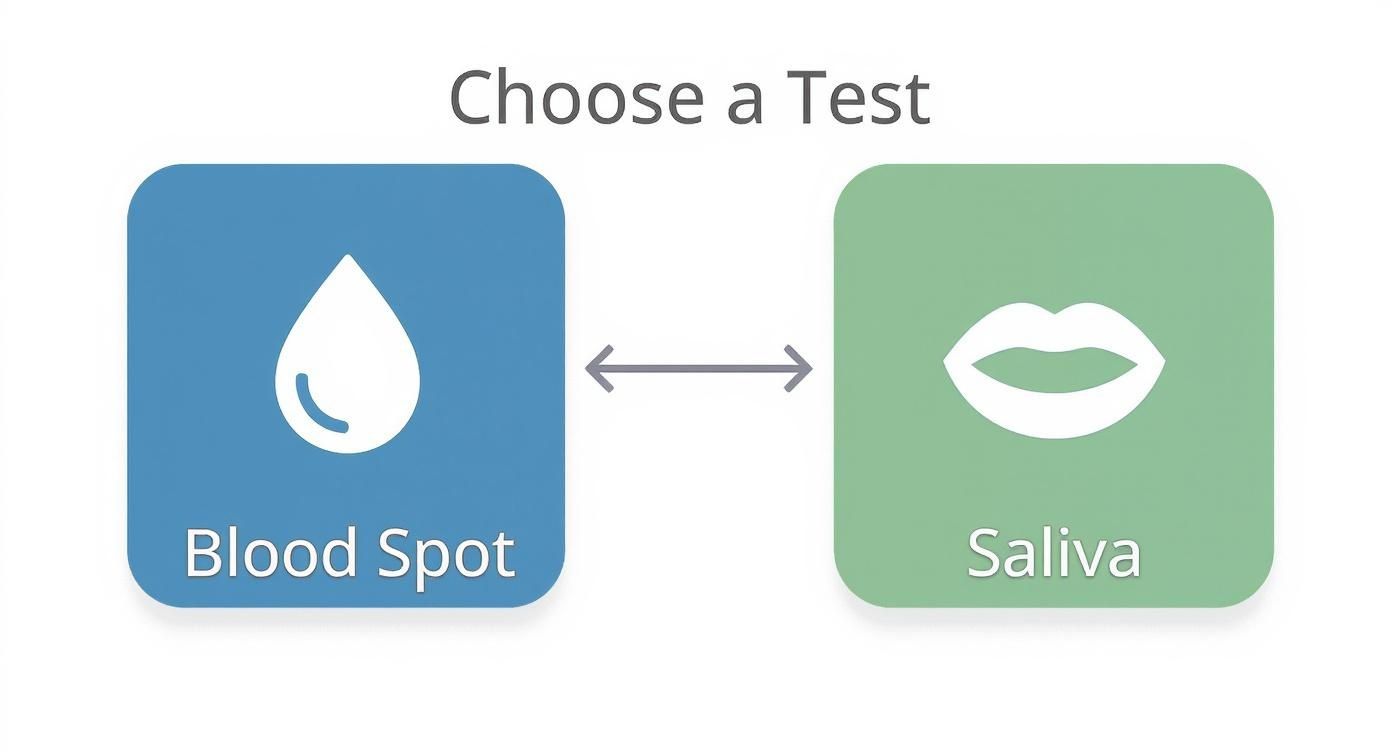Your Guide to a Home Testosterone Test

A home testosterone test is a simple kit you can use to collect a saliva or blood sample right from the comfort of your own home. Think of it as a private, accessible first step toward understanding your hormonal health, all without needing an initial doctor's visit.
Why At-Home Health Testing Is on the Rise

We’re in a new age of personal health where taking charge is easier than ever before. The days of waiting weeks for a doctor's appointment just to get some initial data are starting to fade. Instead, a powerful shift toward proactive, at-home health management is taking hold, and the home testosterone test is a perfect example of this change.
This is all about empowerment. It’s driven by a growing desire for more control over our own health information, giving us a discreet way to check out potential issues before they become bigger problems. Rather than just guessing about symptoms like fatigue, low libido, or mood swings, you can gather some real data first.
The Appeal of Convenience and Privacy
A home testosterone test is best seen as a preliminary screening—a confidential way to look under the hood of your hormonal engine. It neatly sidesteps the common roadblocks that stop people from getting help, like packed schedules, anxiety about visiting a clinic, or the awkwardness of discussing sensitive health topics.
This ease of access has sparked some serious market growth.
The global at-home testing market was valued at USD 7,432.3 million in 2024 and is projected to climb to USD 7,789.1 million in 2025, driven by the demand for self-diagnostic tools. Discover more insights about the at-home testing market on futuremarketinsights.com.
This guide is built to be your go-to resource, helping you understand how these tests work and, more importantly, what to do with the results you get. Whether you're just curious about your baseline levels or you're dealing with specific symptoms, a home hormone test kit can offer the initial clarity you need to start a productive conversation with a healthcare professional. We’ll walk you through every step, making sure you feel confident from the very start.
How a Home Testosterone Test Actually Works

So, what's really going on inside one of these kits? A home testosterone test isn't some magical gadget—it's a straightforward scientific tool designed for convenience. Think of it less like a full diagnostic machine and more like a car's dashboard light. It’s an initial, crucial alert that something might need a closer look from a professional.
These kits are built to measure specific biomarkers in your body. In simple terms, biomarkers are just measurable substances that give us clues about what's happening internally. For testosterone, the two most important ones are Total Testosterone and Free Testosterone, which together provide a snapshot of your hormonal health.
The Key Players: Total and Free Testosterone
To make sense of your results, you need to understand that your body has two main forms of this vital hormone. Both are important, but they tell different parts of the story.
- Total Testosterone: This is the big-picture number. It measures every bit of testosterone in your bloodstream, including the testosterone that’s bound to proteins and the portion that’s "free" and unattached.
- Free Testosterone: This is the hormone that’s unbound and ready for your body to use. It’s the active portion that gets to work influencing things like muscle mass, libido, and energy levels.
A home testosterone test analyzes your sample to figure out the levels of these two key metrics. While total testosterone gives you an overall count, free testosterone often gives you better insight into how you’re actually feeling, since it’s the hormone your body can put to work right now.
A home test provides a vital baseline reading. For men, healthy total testosterone levels typically range between 300 to 1,000 ng/dL. Keep in mind, these numbers can vary based on your age and the specific lab that analyzes the sample.
Sample Collection: The Science in Action
So, how does the kit actually measure these levels from a simple sample you take at home? It all comes down to one of two common collection methods, each with its own way of detecting hormones.
The two main types of home testosterone test collection methods are:
-
Dried Blood Spot (DBS): This is the most common method you'll see. You use a small, provided lancet to prick your fingertip and place a few drops of blood onto a special collection card. As the blood dries, it preserves the hormones, making them stable enough for transport to a lab. Once there, technicians use a technique called immunoassays to measure the hormone concentrations. This approach is often preferred for its accuracy in measuring total testosterone.
-
Saliva Test: This non-invasive option just requires you to collect a small amount of saliva in a tube. The lab then measures the free testosterone that has passed from your bloodstream into your saliva. While it’s definitely easier to collect, this method usually only measures free testosterone and can be more easily contaminated by things like food, drinks, or even brushing your teeth.
Both methods are designed to turn a simple biological sample into hard data, giving you a preliminary look at your hormonal health from the privacy of your own home.
Comparing Blood Spot and Saliva Testing Methods
When you start looking into a home testosterone test, you'll quickly run into two main options for collecting your sample: the dried blood spot test and the saliva test. While both are designed to be done from the comfort of your home, they work very differently and each has its own set of pros and cons. Think of it like choosing between a detailed satellite image and a local street map—both are useful, but for different things.
The fact that these kits are becoming so common speaks volumes. The market for testosterone test kits is booming, valued at USD 1.37 billion in 2024 and expected to nearly double to USD 2.65 billion by 2034. Blood testing still leads the pack because of its long-standing reputation for accuracy, but saliva tests are quickly catching up thanks to how easy and non-invasive they are. You can discover more insights about the test kits market on expertmarketresearch.com.
This trend really gets to the heart of the choice you have to make: are you prioritizing pinpoint accuracy or ultimate convenience?
The Blood Spot Test: A Deeper Dive
The dried blood spot (DBS) test is the go-to method for most at-home testosterone testing, and for good reason. It’s a simple, quick finger prick that lets you collect a few drops of blood onto a special card.
The huge advantage here is that a blood sample measures your total testosterone. Most of the testosterone in your body is bound to proteins circulating in your blood, so this method gives you the most complete picture of your overall hormone levels. Labs consider it the gold standard for at-home screening because it mirrors what happens in a traditional clinical setting.
Key Takeaway: The blood spot test is your best bet for a comprehensive baseline. It gives a broad, reliable overview of your total testosterone, making it a solid first step for anyone looking into their hormonal health.
The only real downside is the collection process itself. While the finger prick is just a minor pinch, some people are understandably squeamish about drawing their own blood, no matter how small the amount.
The Saliva Test: Convenience Is King
If the thought of a finger prick makes you hesitate, the saliva test is your answer. It's completely painless—you just spit into a collection tube. It really doesn’t get any simpler.
But that convenience comes with a trade-off. Saliva tests primarily measure free testosterone. This is the small, "active" fraction of the hormone that isn't bound to proteins. While knowing your free testosterone is incredibly important, it doesn't give you the full story of your body's total T production.
Saliva samples are also much more prone to contamination. Simple things like eating, drinking, or even brushing your teeth right before the test can throw off your results. That’s why following the pre-test instructions to the letter is absolutely critical if you want an accurate reading.
Blood Spot vs Saliva Home Testosterone Test
To make the choice clearer, let's break down the key differences between a blood spot and a saliva test. This side-by-side comparison should help you decide which method aligns best with your goals and comfort level.
| Feature | Blood Spot Test | Saliva Test |
|---|---|---|
| Accuracy | High; considered more reliable for total testosterone. | Good for free testosterone but can be less consistent. |
| Biomarkers Measured | Measures both total and free testosterone. | Primarily measures free testosterone. |
| Sample Collection | Requires a finger prick to collect blood drops. | Non-invasive; requires spitting into a tube. |
| Risk of Contamination | Low risk if hands are clean. | Higher risk from food, drinks, and oral hygiene. |
| Best For | Getting a comprehensive baseline of your hormone levels. | Tracking free testosterone levels with maximum convenience. |
Ultimately, neither test is inherently "better"—they just serve different purposes. If you want a complete, foundational look at your hormone health that closely resembles a clinical test, the blood spot test is the way to go. If your main goal is to easily track your active testosterone levels without any discomfort, the saliva test is a fantastic option, as long as you're diligent about following the collection rules.
A Step-by-Step Guide to Taking Your Test Correctly
You’ve got your home testosterone test kit in hand, and now it's time for the most important part: collecting your sample. Getting this step right is the single biggest factor in whether your results are reliable. Think of it like baking—even a small mistake in the recipe can throw off the entire outcome. This guide will walk you through the process, making sure you feel confident every step of the way.
First things first: preparation. This actually starts before you even open the box. Timing is everything. Your testosterone levels naturally peak in the morning, which is why almost every test will tell you to collect your sample within the first hour of waking up. For the cleanest reading, you also need to be in a fasted state. That means no food or drinks (except water) for at least eight hours beforehand.
Preparing for Sample Collection
Before you start, find a clean, flat surface and lay out everything from your kit. Wash your hands thoroughly with soap and warm water. This isn't just about sanitation; the warm water also helps get the blood flowing to your fingertips, which will make the next step much easier.
A few extra tips can make this process even smoother:
- Hydrate Well: Drink a full glass of water about 20 minutes before you plan to take the sample.
- Get Moving: Do a few jumping jacks or just swing your arms around for a minute to boost your circulation.
- Activate Your Kit: Most kits have a unique code inside the box that you need to register online. Do this before you collect your sample. This step is what links your specific sample to your account so you can get your results back.
Collecting and Shipping Your Sample
With all your prep work done, you're ready for the main event. If you're using a blood spot test, grab the provided alcohol wipe and clean off your chosen fingertip. The side of your ring or middle finger usually works best. Let it air dry completely before you do anything else. Use the lancet to make a quick prick, then gently massage your finger from the base toward the tip to help form a nice, round drop of blood.
Apply the drops to the designated circles on the collection card, making sure to fill each one completely. Try not to smear the blood or touch the card with your finger. For saliva tests, the process is a bit simpler but requires the same level of care. You'll need to avoid eating, smoking, or brushing your teeth for at least 30 minutes before collecting to prevent contaminating the sample.
This infographic shows the simple, two-path process for collecting your sample, whether you've chosen a blood spot or saliva test.

As you can see, both methods are straightforward, but they each have their own precautions to ensure you get a clean, usable sample.
Critical Step: Let your blood spot sample air dry completely. The instructions will tell you how long, but it's usually for several hours. If you package it while it's still wet, you'll ruin the sample, get an invalid result, and have to start all over again.
Once your sample is properly collected and prepared, package it exactly as the kit's directions show. This usually means placing it in a small biohazard bag and then into the pre-paid mailer. Try to drop it off at the post office the same day. From here, a CLIA-certified lab takes over, analyzing your sample to give you the data you need. To get a better sense of what happens next, explore our guide on how to check hormone levels at home for more details on the lab process.
Understanding and Interpreting Your Results
Getting your test results in hand is a big moment. But cracking open that report and seeing a wall of numbers and medical jargon can feel pretty intimidating. Don't sweat it—making sense of these figures is more straightforward than it looks. The key is to see them not as a final verdict, but as the starting point for a smarter conversation about your health.
Think of your testosterone level like a single weather report. A reading of 75°F is useful information, but it doesn't tell you the whole story about the climate. In the same way, your result is just a snapshot of your hormone levels at one specific moment. It’s a valuable piece of data, but it’s not the entire picture.
What Are Reference Ranges
Your report will show your testosterone level right next to a "reference range." This is simply the typical range of values found in a large, healthy group of people. For instance, a common lab range for total testosterone in adult men might be between 300 to 1,000 ng/dL.
It’s crucial to know that these ranges can vary a bit from one lab to another. They are just a guidepost. Falling slightly outside the lines isn't an automatic reason to panic, just as being inside the range doesn’t guarantee you won't have symptoms.
Your personal "optimal" level is tied to a bunch of factors, like your age, lifestyle, and frankly, how you feel day-to-day. A number that’s perfectly fine for a 65-year-old might be on the low side for a 25-year-old.
Context is everything. That single number from your home test needs to be looked at alongside your complete health story—your energy, mood, sex drive, and overall well-being. This is why trying to diagnose yourself is so risky; a number without context is just a number. For a deeper dive into making sense of the data, you can check out our guide on how to read lab results.
Your Result Is a Starting Point
The growing interest in managing hormone levels has fueled a massive market. Take testosterone booster supplements, for example. That market was valued at USD 3.78 billion in 2024 and is expected to hit USD 8.39 billion by 2032. This explosion shows just how many people are searching for answers, making accurate testing and proper interpretation more important than ever. Discover more insights about the testosterone supplements market on snsinsider.com.
Your home testosterone test result is meant to be a powerful tool to bring to a healthcare professional. It gives you solid data to kickstart a real, meaningful discussion. Your doctor will take this information, combine it with your symptoms and possibly more tests, and build a complete picture of your hormonal health.
What to Do After You Get Your Results
Getting your results from a home testosterone test is a huge first step, but it’s definitely not the finish line. Think of this report as a map that points you in the right direction. Its real power comes from using it to navigate your next moves with a healthcare professional, turning that raw data into a meaningful action plan.
Your main goal now is to book a consultation with a doctor. A home test is a fantastic screening tool, but it can't take the place of a formal medical diagnosis. A doctor will use your results as the starting point for a much deeper evaluation, which is absolutely essential for understanding the full picture of your health.
Preparing for Your Doctor's Appointment
To get the most out of your appointment, you need to show up prepared. Don't just walk in with a number; bring the context that gives that number meaning. This prep work ensures you and your doctor can have a productive, collaborative conversation.
Here’s what you should have with you:
- Your Home Test Results: Bring a printed copy, or have the digital report pulled up on your phone, ready to go.
- A Symptom Log: For a few weeks before your appointment, keep a simple journal of how you're feeling. Make notes on your energy levels, mood, sleep quality, and libido.
- A List of Questions: Write down everything you want to ask. This could be anything from what your levels mean for your age to what kind of follow-up testing might be needed.
A clinical blood draw is almost always the next step. While your home test provides a valuable snapshot, doctors rely on a venous blood test for the level of accuracy needed to make an official diagnosis and talk about treatment options.
By taking these steps, you turn your home testosterone test from just a number into a powerful tool for taking control of your health.
Your Questions Answered: Getting Clear on Home Testing
Even after walking through the process, it's completely normal to have a few questions pop up. When you're thinking about taking the first step with a home testosterone test, you want to feel confident you have all the facts. Let's tackle some of the most common questions we hear from people just like you.
Think of this as your quick-reference guide to clear up any lingering uncertainties.
How Accurate Are These Tests, Really?
This is probably the most important question on everyone's mind. The short answer is that home testosterone tests from reputable, CLIA-certified labs are surprisingly accurate for what they're designed to do: initial screening. They give you a reliable first snapshot of your hormone levels, helping you figure out if there’s a potential issue worth looking into.
However, and this is a critical point, they are not a substitute for a formal clinical diagnosis. Think of a home test as a dependable warning light on your car's dashboard—it tells you it’s time to see a mechanic. A healthcare provider will almost always order a follow-up venous blood draw to confirm any results before making an official diagnosis or talking about treatment.
Does Insurance Ever Cover Home Testosterone Tests?
In almost all cases, direct-to-consumer home testosterone tests are an out-of-pocket expense and aren't covered by health insurance. The price tag can swing a bit depending on the company, the lab they partner with, and how many different biomarkers you're getting tested in the kit.
On the flip side, if a doctor orders a testosterone test for you because of specific symptoms you're having, that lab work is far more likely to be covered by your insurance. The key difference is medical necessity. A test you order yourself is for screening, while one a doctor orders is considered a necessary diagnostic step.
Can I Use a Home Test to Diagnose Low T Myself?
No, you absolutely cannot—and should not—try to self-diagnose low testosterone with a home test. A real medical diagnosis is a nuanced process that can only be handled by a licensed healthcare professional.
A doctor doesn't just look at a number on a lab report. They connect the dots between your test results, a physical exam, the specific symptoms you're experiencing, and your entire medical history. A home testosterone test is a fantastic tool for gathering preliminary data and starting a meaningful conversation with your doctor, but it's not meant to give you the final answer on your own.
Ready to take the first step in understanding your hormonal health? Elite Bioscience offers discreet, reliable at-home testing solutions to provide the clarity you need. Explore our options and begin your journey today at https://elitebioscience.co.
QUICK SEARCH
Make an account today to start your journey towards a better and healthier lifestyle.






